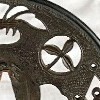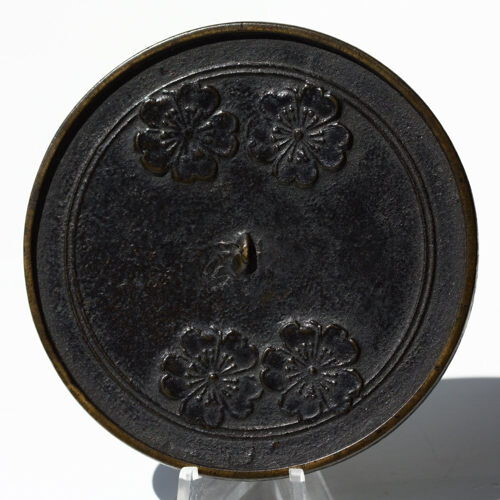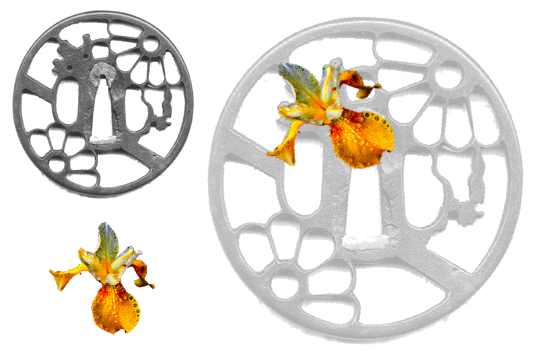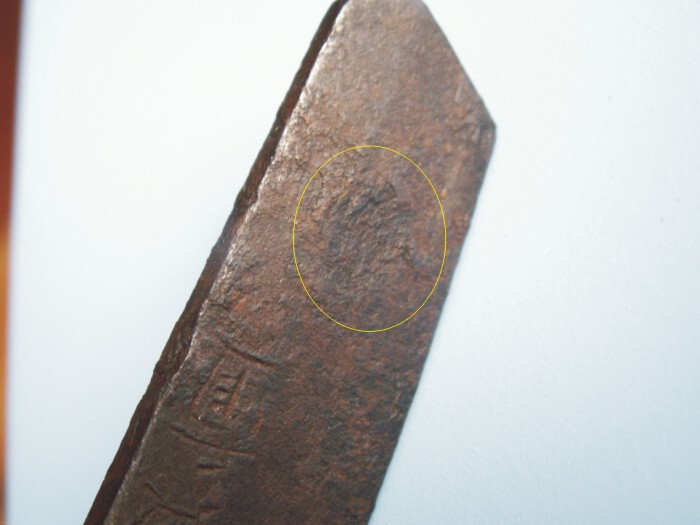-
Posts
3,157 -
Joined
-
Last visited
-
Days Won
26
Content Type
Profiles
Forums
Events
Store
Downloads
Gallery
Everything posted by Marius
-
Dear All, the sukashi on this ko-kinko tsuba - is that suhama (beach)? Or maybe hirute? (drawer handle). Any ideas of what this shape is and how it is called? Google would produce poor results... The second tsuba has a similar sukashi, said to be bracken...
-
I have allowed myself to write a short review of Nakahara Nobuo's book (with contributions by Paul Martin). You may find it interesting. If not, please ignore my ramblings: http://gomabashi.blogspot.com/2011/01/r ... s-and.html
-
I would say this is the upper part of a a cut-down naginata pole. They often cut down long poles to ship them. This looks like such a case...
-
I bet this is a cut-down naginata pole.
-

Yoshimichi Ubu, but tang is super short??
Marius replied to diprivanman's topic in Auctions and Online Sales or Sellers
what? -

Does anyone know what this is???
Marius replied to Dakota's topic in General Nihonto Related Discussion
Luis, people here are always prepared to share their knowledge, so the lesson should be smooth if you are prepared to listen :-) I'll try to put together all fact that make it quite obvious that your blade and mounts are modern, low quality items: 1. Shape: very unusual for a tanto 2. No hamon (temperline) - your hamon is etched, it is not the result of tempering. 3. Habaki (metal collar which keeps blade in the sheath): no Japanese habaki has a ridge, except maybe for some habaki on ken 4. Nakago (tang) - unregular shape, fresh red artificially rust induced by the maker, signature sloppy, unusual and sloppy filemarks 5. Mountings (handle and sheath): strange, light alloy - this is not copper aor any of its alloys. Besides, this is a cast piece, no craftsmanship whatsoever here The way for you to go: 1. visit a few websites with information about nihonto (start with http://home.earthlink.net/~steinrl/nihonto.htm , http://www.ksky.ne.jp/~sumie99/information.html , http://www.nihontocraft.com/japanese_sword_terms.html , but there are many others) - you will find a wealth of links on the NMB welcome page: http://nihontomessageboard.com/ 1 a. read whatever you find interesting among the threads of this forum 2. visit dealer websites: http://aoi-art.com/ and http://yakiba.com/nihonto.htm to start with 3. buy a few books, you might start with three, but you will need many, many more: Samurai Sword a Handbook, J.M. Yumoto The Craft of the Japanese Sword, Leon Kapp, et al The Japanese Sword A Comprehensive Guide (Japanese Arts Library), Kanzan Sato, Joe Earle 4. Ask some benevolent collector to show you a real Japanese art sword or maybe go to a sword show (observe the strict etiquette) 5. Buy more books 6. Once you know sword periods and main schools and you take a liking in one of them, consider buying a sword (be patient, don't jump on any sword you see, come back here for advice when you think of buying). I guess that is all. Everyone here has gone more or less the same way. Good luck to you. We would love to see you back here :-) -

Does anyone know what this is???
Marius replied to Dakota's topic in General Nihonto Related Discussion
Luis, Check out this site: http://www.jssus.org/nkp/fake_japanese_swords.html -
Bob, Pierce, it seems you are right with the iris-bridge connection. I am pretty sure that those two holes in the upper left part over the seppa dai represent dew drops. The three-pronged, irregular bit may represent the upper part of an Iris. So what we may have here is a bridge, an iris, dewdrops and chrysanthemum. Below is an iris overlaying the tsuba... I guess we can consider this puzzle solved now :D
-
This seller has quite a few Chinese "antiques". I suggest you read this: http://reviews.ebay.com/The-Brutal-Trut ... 0005820898 Without a documented provenance this "Kofun" item should be treated as a Chinese "antique". It has to be said, however, that this sellers nihonto are real.
-
And a Merry Christmas to you, Henry :D This is a beautiful tsuba. Well done, Santa! I won't comment on what it is, as I have read about it elsewhere If you know where to get similar tsuba, do let me know :lol:
-
No, this is unlikely. It does look like it is part of the original design. The only problem is... what is it? I had an association with a bridge, too :-) But those irregular bits drive me nuts
-
Hello, I have an Akasaka (said to be the 7th Tadatoki) with an interesting design. The blossoms look like chrysanthemum, but what are the other elements? The two little holes over the kozuka-hitsu-ana are quite intriguing... Also, please note the asymmetric arrangement of the hitsu-ana... Any help will be greatly appreciated
-
Nobuo Nakahara would disagree.
-
Keith, I am afraid that your first impression was correct. This seems to be a cast tsuba, with the seems filed down. No tagane, no clear seppa-dai.... no detail, a constricted design...
-
I said this, although you do misquote me. Would you care to elaborate? What can you possibly study on a blade out of polish (I did not say "newly polished"), besides the sugata and the state of the nakagao (if it has not been ruined, that is)?
-
Sorry, but you will not learn much from a sword which is not polished.
-
Jock, I think Keith was well-meaning in his post. He has only commented on your decision to buy this particular sword. And he has remarked that your original post has yielded some interesting aspects concerning polishing. You are absolutely right - not many people can afford $$$$$ blades. But you can always save up (as I do, in fact) for a polished blade with no serious problems. Five $200 junk blades can buy you one polished wakizashi - it may not be a masterpiece, but it will be a decent sword to enjoy and to learn from. Buying unpolished blades will keep you from appreciating what nihonto really is. Hope you are not offended by my post
-
Jock, I am really sorry for you, believe me, I am. But, what on earth have you expected from a purchase of a sword in cheap koshirae, out of polish and with a tsuka that could not be removed? I know it didn't cost a lot of money, but still...
-
Yury, I am sorry, but the horimono is just awful. No precision in the carving whatsoever, and the composition is a mess. And, sorry to say that, this does not seem to be just a bad photograph Sorry for being so blunt, but this is how I see it...
-
Keith, please have a look at this; http://www.ksky.ne.jp/~sumie99/sword16.html
-
Louis, as a person with great experience in collecting shoshin which turn out to be gimei I am rather skeptical, that is all. I am always very very happy to be proved wrong
-
I think the reasoning is as follows: 1. Not all naginata had naginata hi (eg. nagamaki). I 2. In naginata with a torii zori the kaeri might have been preserved because the boshi was left intact (actually, I used to have such a naginata naoshi, a sue-Soshu cut down to a rather broad wakizashi) otherwise there is no reason to see it as a former naginata...
-
Dear All, I used to own a sword, a Shitahara school wakizashi by Hiroshige. It had 1979 Tokubetsu Kicho papers from the NBTHK. I have recently sold it and the buyer (a pal of mine), upon closer examination, has come to the conclusion that the blade is in fact osuriage. He has found what looks like the original mekugi ana close to the tip of the nakago, and I agreed, it looked quite like a plugged hole. I have offered him to take the sword back, but he did like it that way, speculating if this could be a wakizashi cut down from a naginata and not gimei. I have insisted it is osuriage gimei with crap origami, but he thinks the signature might still be original. What do you think - anything in the papers that would support his theory? Attached are some pics.
-
There is an excellent article by Boris Markhasin and Andy Mancabeli - it deals with the technical and functional side of tekkotsu. You might want to google "Muromachi Period Iron Tsuba & Armor – Similarities in Material, Function and Manufacture"
-
Dear Yimu, I don't want to be a purist, but it should be "two tsuba" The plural for tsuba is... tsuba :D









